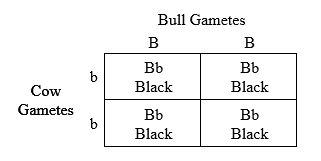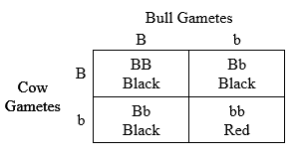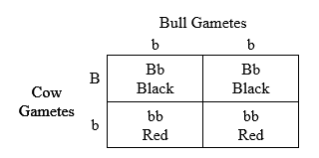Enhanced comment feature has been enabled for all readers including those not logged in. Click on the Discussion tab (top left) to add or reply to discussions.
Monogenic Traits: Difference between revisions
No edit summary |
No edit summary |
||
| Line 7: | Line 7: | ||
When dealing with traits with complete dominance, heterozygous animals are often called carriers because they are carrying the recessive allele and can pass it to their offspring even though they do not express the recessive phenotype themselves. That is why it is possible to breed two black animals and get a red calf; each parent was a red allele carrier. | When dealing with traits with complete dominance, heterozygous animals are often called carriers because they are carrying the recessive allele and can pass it to their offspring even though they do not express the recessive phenotype themselves. That is why it is possible to breed two black animals and get a red calf; each parent was a red allele carrier. | ||
Coat color is a good trait to demonstrate how alleles interact in a trait with complete dominance. For this example, we will mate an Angus bull to Hereford cows. The Angus bull is homozygous dominant, which means he has two black alleles (BB). The Hereford cows are homozygous recessive, which means they have two red alleles (bb). When mated, all offspring will be heterozygotes (Bb). The Punnett Square in Figure 1 illustrates this mating. | Coat color is a good trait to demonstrate how alleles interact in a trait with complete dominance. For this example, we will mate an Angus bull to Hereford cows. The Angus bull is homozygous dominant, which means he has two black alleles (BB). The Hereford cows are homozygous recessive, which means they have two red alleles (bb). When mated, all offspring will be heterozygotes (Bb). The Punnett Square in Figure 1 illustrates this mating. Cow gametes are egg cells, and bull gametes are sperm cells. | ||
'''Figure 1. Punnett Square for coat color when mating a homozygous black bull to homozygous red cows. The joining of the gametes | '''Figure 1. Punnett Square for coat color when mating a homozygous black bull to homozygous red cows. The joining of the gametes shows the potential genotypes of offspring and their phenotype (color).''' | ||
[[File:Punnett_Square_Black_Bull_Red_Cow.png]] | [[File:Punnett_Square_Black_Bull_Red_Cow.png]] | ||
Revision as of 14:24, 3 December 2019
Monogenic traits – characteristics that are fully determined by one gene – tend to be the exception rather than the rule in livestock genetics. Having said that there are a number of important traits such as coat color and some genetic conditions that are monogenic, and understanding their inheritance is important.
All individuals receive one copy (allele) of each gene from their mother, and one from their father. The DNA sequence of a gene inherited from each parent may be identical in which case the individual is said to be homozygous for that gene, or the sequence of a gene inherited from each parent may vary in which case the individual is said to be heterozygous. Alleles can be recessive, meaning that an animal must inherit the same allele from both parents (i.e. be homozygous) before there is an effect, additive meaning that the effect is proportional to the number of alleles inherited by the animal (i.e. carrying two copies of a particular allele produces double the effect of carrying one copy), or dominant meaning that the inheritance of a single dominant allele can completely mask the expression of the allele inherited from the other parent.
For simply inherited traits one allele completely masks the expression of the other allele when the alleles are heterozygous for the gene. This results in heterozygote animals having the exact same phenotype as homozygote dominant animals. This is the type of dominance we see in red/black coat color, where black is dominant to red. Cattle that have two black alleles are black (homozygous dominant), cattle that have one black and one red allele are also black (heterozygous), and red animals are the result of having two red alleles (homozygous recessive).
When dealing with traits with complete dominance, heterozygous animals are often called carriers because they are carrying the recessive allele and can pass it to their offspring even though they do not express the recessive phenotype themselves. That is why it is possible to breed two black animals and get a red calf; each parent was a red allele carrier.
Coat color is a good trait to demonstrate how alleles interact in a trait with complete dominance. For this example, we will mate an Angus bull to Hereford cows. The Angus bull is homozygous dominant, which means he has two black alleles (BB). The Hereford cows are homozygous recessive, which means they have two red alleles (bb). When mated, all offspring will be heterozygotes (Bb). The Punnett Square in Figure 1 illustrates this mating. Cow gametes are egg cells, and bull gametes are sperm cells.
Figure 1. Punnett Square for coat color when mating a homozygous black bull to homozygous red cows. The joining of the gametes shows the potential genotypes of offspring and their phenotype (color).
If we were to breed these heterozygous heifers back to a Hereford bull, we would get fifty percent heterozygous black (Bb) calves and fifty percent homozygous red (bb) calves (Figure 2).
Figure 2. Punnett Square for coat color when mating a homozygous red bull to heterozygous black cows. The joining of the gametes shows the potential offspring and their color.
If we were to mate the Hereford x Angus heifers to Hereford x Angus bulls then we would get all three possibilities: homozygous black (BB), heterozygous black (Bb) and homozygous red (bb) (Figure 3). The ratio would be 25%:50%:25%, respectively. The phenotypic ratio would be 75%:25% black to red.
Figure 3. Punnett Square for coat color when mating a heterozygous black bull to heterozygous black cows. The joining of the gametes shows the potential offspring and their color.
Traits controlled by one gene, with complete dominance, are easy to understand, but can cause problems because of the possibility of carriers of recessive genetic defects. For some traits, the only way to detect carriers is through progeny testing, which is costly and time consuming. However, with advancements in molecular technologies, carriers can be identified for many traits by conducting a DNA test on a tissue sample (See below).
The simplest way to avoid having homozygous recessive calves is to always breed to a homozygous dominant bull. With this breeding strategy, even if you have the undesirable allele in your herd it will never be expressed because only homozygous dominant or carrier calves will be produced. This strategy can improve markets in the case of the red and horn allele, and increase reproductive rates when lethal alleles are involved.
For more in-depth information you can access these fact sheets:


